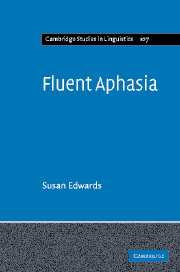Book contents
- Frontmatter
- Contents
- List of figures
- List of tables
- Acknowledgements
- Introduction
- 1 Fluent aphasia: identification and classic descriptions
- 2 Descriptions of fluent aphasia
- 3 Assessment and fluent aphasia
- 4 Connected fluent aphasic speech
- 5 Non-fluent and fluent aphasic speakers. What are the differences?
- 6 Comprehension and processing problems in fluent aphasia
- 7 The manifestation of fluent aphasia in one speaker
- 8 Some concluding thoughts
- References
- Index
3 - Assessment and fluent aphasia
Published online by Cambridge University Press: 22 September 2009
- Frontmatter
- Contents
- List of figures
- List of tables
- Acknowledgements
- Introduction
- 1 Fluent aphasia: identification and classic descriptions
- 2 Descriptions of fluent aphasia
- 3 Assessment and fluent aphasia
- 4 Connected fluent aphasic speech
- 5 Non-fluent and fluent aphasic speakers. What are the differences?
- 6 Comprehension and processing problems in fluent aphasia
- 7 The manifestation of fluent aphasia in one speaker
- 8 Some concluding thoughts
- References
- Index
Summary
Introduction to some aphasia assessments
The presence of aphasia is suspected when there is a sudden loss of language ability usually accompanied by other neuropathological signs. Aphasia may be manifested by problems with the production of words and sentences while comprehension remains relatively intact. People presenting with aphasia who are taken into medical care in the UK will have an aphasia assessment. This will involve a clinician administering various tests but the nature of the tests used will depend on the discipline of the clinician conducting the assessment. Physicians and other medical personnel may run through a few simple tasks such as asking patients to give their name and address, to name a few common objects, a watch, a pen, a glass of water and to point to various objects in the room. This type of exercise contributes to the medical diagnosis but cannot really be thought of as an aphasia assessment. Aphasia assessments, while varying in content, detail and focus, all aim to provide information about the type of disorder rather than the presence of aphasia. If the patient enters into a rehabilitation programme, then an assessment may be given to establish base-lines before clinical intervention and to check change in language performance over time, in order to inform the planning of therapy.
- Type
- Chapter
- Information
- Fluent Aphasia , pp. 62 - 91Publisher: Cambridge University PressPrint publication year: 2005



